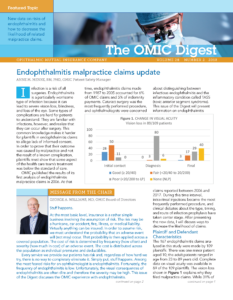
Risk Management
| << Back |
Endophthalmitis outbreak following intravitreal injections
Ryan M. Bucsi, OMIC Claims Manager
On 1/26/16 and 1/27/16, a non-OMIC ophthalmologist at an OMIC-insured practice injected 8 patients, aged 64 to 94, with Avastin or Eylea to treat neovascular age-related macular degeneration. The patients’ visual acuities in the eyes to be injected ranged from 20/25 to 20/150. The ophthalmologist added dexamethasone to the anti-VEGF medication. The dexamethasone was withdrawn from the same single-dose vial for all 8 patients. The ophthalmologist used the needle included with the Eylea kit to puncture the dexamethasone vial after puncturing the Eylea vial. The prepackaged Avastin needle was used to puncture the dexamethasone vial and then was used again to inject the patients. Betadine and Navobay Hypochlorous solution was used to prep for the treatment. Following the injections, the ophthalmologist pressed on each of the treated eyes with his bare finger to check the pressure. Each patient returned within 2 to 3 days complaining of decreased vision and pain and was diagnosed with endophthalmitis. Despite treatment, each patient lost visual acuity. The visual acuities post-injection ranged from 20/200 to hand motion.
Analysis
OMIC’s retained expert opined that both the non-OMIC ophthalmologist and the OMIC-insured practice failed to meet the standard of care. The expert criticized the following aspects of the care. None of the consent forms for Avastin and Eylea mentioned anything about the addition of dexamethasone. The records were sloppy and inaccurate with no specific operative note. Adding steroids to an anti-VEGF medication was unnecessary: there are no clinical trials demonstrating that adding steroids increases the effectiveness of Avastin or Eylea. Puncturing a single-dose vial multiple times with the needle from the Avastin or Eylea, and then using the same needle to inject the patient, was beneath the standard of care. Pressing on the eye with a bare finger after injecting the anti-VEGF medication to check the pressure could have contributed to the infection.
The expert also raised concerns about the drugs used to anesthetize the eye. The patients received subconjunctival injections of Marcaine and Lidocaine. It is unclear why Marcaine was used, since the anti-VEGF procedure only lasts a few minutes. The drugs were presumably drawn from separate vials using the same syringe, another possible source of infection. The expert also questioned the pre-injection preparation using both Betadine and Navobay Hypochlorous solution. There is nothing in the literature to support the use of Hypochlorous solution before an intravitreal injection. The ophthalmologist should have just used Betadine.
The expert also criticized the role the staff at the OMIC-insured practice was asked to play. The technicians—not the physician—obtained informed consent for the injections. In addition, the technicians at times drew up the dexamethasone from the single-use vial and added it to the Avastin or Eylea, compounding the drug when the MD should have done so. The technicians, like the ophthalmologist, did not wear gloves when handling the patients. After washing or sanitizing their hands, the ophthalmologist and the technicians adjusted the chair numerous times, then touched the patient, which was another possible source of contamination.
Takeaway
Seven of the eight patients filed lawsuits against the ophthalmologist and practice. From OMIC’s perspective, these cases were indefensible and needed to be settled versus trying each of these 7 cases in front of 7 different juries. OMIC felt that the treatment by the non-OMIC insured ophthalmologist was likely the source of this endophthalmitis outbreak, especially since he touched the eyes following each injection with his bare hand. However, there were multiple potential sources of endophthalmitis in these cases, including the way the dexamethasone was added to the anti-VEGF medications. Therefore, OMIC settled these 7 cases on behalf of our insured entity. The multispecialty carrier for the ophthalmologist placed the blame for this endophthalmitis outbreak solely on the OMIC-insured technicians and opined that the ophthalmologist met the standard of care. The other carrier also questioned the credentials of our retained expert and championed its insured as a much more qualified expert in the field of ophthalmology. Eventually, the multispecialty carrier settled the cases on behalf of the ophthalmologist.
Please refer to OMIC's Copyright and Disclaimer regarding the contents on this website






